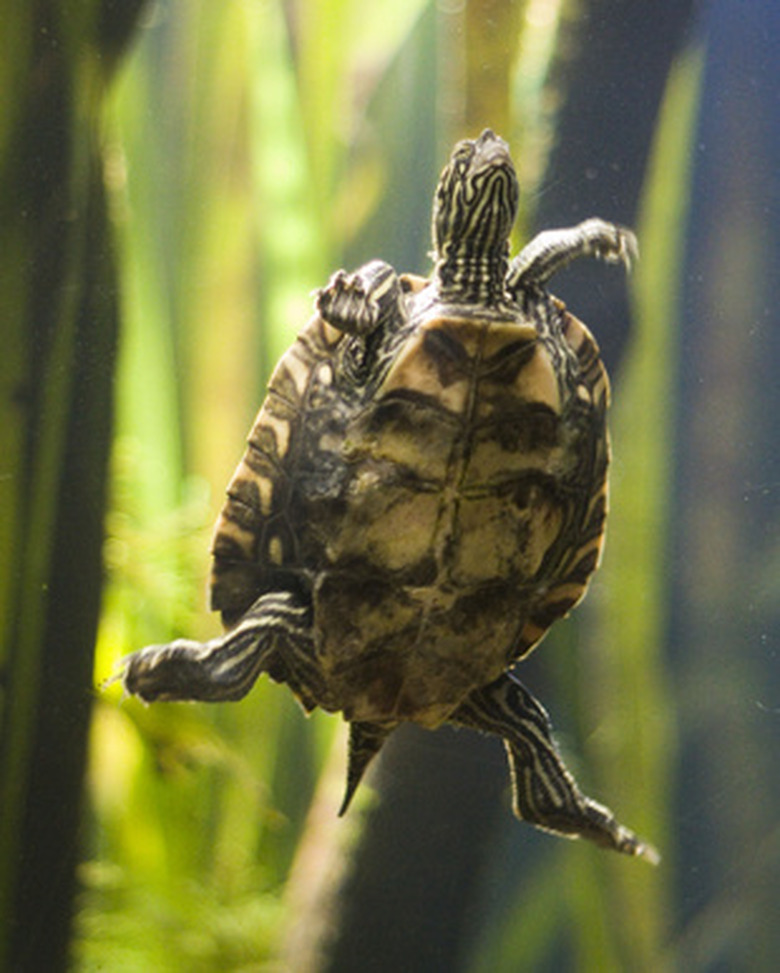How To Take Care Of A Fresh Water Turtle
Things Needed
-
Tank
-
Water
-
Biological filter
-
Heat lamp
-
Heater
-
Logs and stones
-
Reptile sticks, feeder worms, leafy greens and live feeder fish
-
UVA/UVB light bulbs
-
Hot, soapy water
Warning
Don't forget to take your freshwater turtles for their annual check-ups. Turtles species are prone to a number of diseases that can be identified by a veterinarian familiar with exotic pets. Shell rot, metabolic bone disease, vitamin deficiencies and respiratory illnesses, affect turtles. If your turtle is not acting like himself or seems lethargic, a vet check may be in order.
Tip
Offer the turtles pieces of potato, broccoli, peppers, carrots, beans or cucumbers now and then as a tasty treat.
Check the laws in your state. In some jurisdictions, you need a license to keep a turtle as a pet.
If you are considering keeping freshwater turtles as pets, it is important to understand that like any reptile, they require special care. Painted turtles, red-eared sliders and Reeve's turtles are among the most common freshwater turtles chosen for pets. While habitat and nutrition are important factors to consider when it comes to caring for your freshwater turtles, keep in mind that captive turtles also require preventative health care. Handling your pet freshwater turtles is also a matter of concern, since captive breeds are still capable of spreading disease.
Step 1
Provide your freshwater turtles with comfortable accommodations. Size matters here, and for one to two freshwater turtles, a 75-gallon tank is the minimum. For two or more, you will need a 100-gallon tank.
Step 2
Fill the tank 1/3 full of water and attach a biological filter to the tank. The biological filter will remove waste material and bacteria from the tank, keeping the water healthy for the freshwater turtles. Keep in mind, even though you are running a filter, the water will still require changing once a week.
Step 3
Attach a heater and a heat lamp to the tank to keep your freshwater turtles warm. The heat lamp will work like the sun, warming the freshwater turtles from above, while the heater will maintain a constant water temperature. Set the dial on the heater to the turtles preferred temperature–between 75 and 85 degrees Fahrenheit.
Step 4
Set a few logs or large stones in the tank. Choose logs or rocks large enough to peek out above the water to give the turtles a resting area to dry out. The heat lamp will warm the resting area, keeping your freshwater pets comfortable.
Step 5
Feed your freshwater turtles a well-rounded diet. Offer your captive turtles reptile sticks and feeder worms as directed on the package labeling. A sprinkling of leafy, green vegetables also helps round out their diet. Add live feeder fish, such as guppies and goldfish to your turtle tank, too. This gives the freshwater turtles an opportunity to hunt for their lunch. Young turtles require daily feedings and adults prefer to eat every two days.
Step 6
Recreate natural light by adding UVA/UVB light bulbs to your tank. The combination of each type of lighting is necessary to the health of your freshwater turtles. In fact, without ultraviolet light, your turtles will not be able to synthesize the vitamin D in their bodies. Turtles need at least 10 to 14 hours of light per day. Switch out the bulbs for fresh ones, every six months.
Step 7
Wash your hands after handling your turtles. The tank environment is a breeding ground for salmonella. When you touch your freshwater turtles, the bacteria can transfer from their bodies to you. Clean your hands with hot, soapy water each and every time you touch your freshwater turtles, the water or tank accessories to prevent infection.
